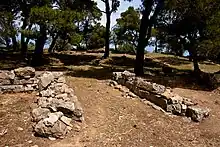
In ancient Greek and Roman architecture, a peribolos was a court enclosed by a wall,[1] especially one surrounding a sacred area such as a temple, shrine, or altar. This area, however, is not a necessary element to these structures since those built earlier only included markers (e.g. horoi or boundary stones) to indicate imaginary boundaries.[2] Excavations reveal that there are sanctuaries that included a peribolos later in its history, signifying a change in religious mentality.[2] During the Roman times, there were pereboloi used as meeting places to conduct business (e.g. shipping).[3]
Peribolos walls (which may also be referred to as temenos walls) were sometimes composed of stone posts and slabs supported by porous sills.
Famous examples included:
- the peribolos wall and gate in the Sanctuary of Zeus (Altis), north of the Temple of Zeus at Olympia, Greece;
- the peribolos enclosing the Altar of the Twelve Gods near the north end of the Athens ancient Agora; and
- the terrace created by retaining and peribolos walls around the Sanctuary of Athena Pronaia (Marmaria), southeast of the Sanctuary of Apollo at Delphi, Greece.
See also
References
- ↑ Rogers, Adam (2011). Late Roman Towns in Britain: Rethinking Change and Decline. Cambridge, UK: Cambridge University Press. p. 96. ISBN 978-1-107-00844-1.
- 1 2 Hagg, Robin; Marinatos, Nanno (2005). Greek Sanctuaries: New Approaches. London: Routledge. p. 7. ISBN 0203432703.
- ↑ Stillwell, Richard (2017). The Princeton Encyclopedia of Classical Sites. Princeton, NJ: Princeton University Press. p. 243. ISBN 9780691654201.
External links